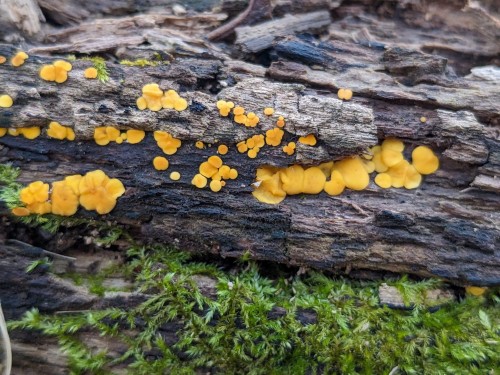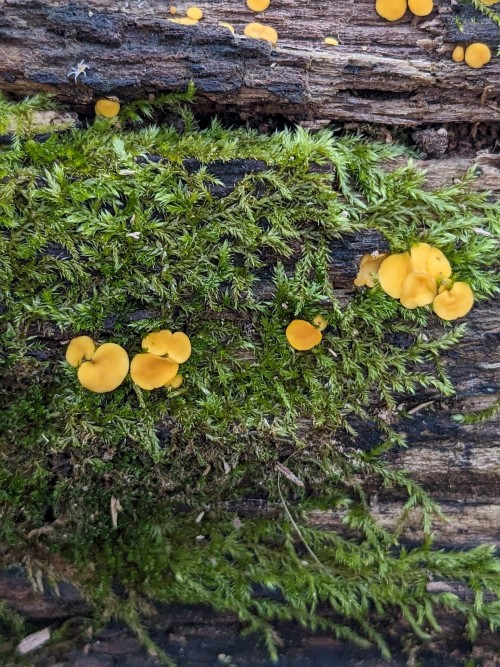
28/Female/Earthling- An amateur naturalist and geology major living in the Missouri Ozarks. Botany 🌿, mycology 🍄, geology 🏔️, foraging 🍓, gardening and more! 🌼🐦🦉🐝 😀 (Natural sciences are my niche.) •iNaturalist ID: oliviarosaline •Rockd Macrostrat Lab: Olivia Myers
86 posts
Wood Wakerobin


Wood Wakerobin
Trillium viride
Endemic to east-central Missouri and south-west Illinois, this trillium species can be found growing in woods with rich soils and on rocky slopes. It blooms in mid to late spring and there are lookalike trilliums; however, T. viride has a characteristic unique only to it - tiny, yet visible stomata that look like white dots all over the top of its leaves.
April 17th, 2024
St. Louis County, Missouri, USA
Olivia R. Myers
@oliviarosaline
-
 abdalla-23 liked this · 8 months ago
abdalla-23 liked this · 8 months ago -
 asikan liked this · 8 months ago
asikan liked this · 8 months ago -
 vuonkhuya liked this · 8 months ago
vuonkhuya liked this · 8 months ago -
 rosewaterdrops reblogged this · 8 months ago
rosewaterdrops reblogged this · 8 months ago -
 el-zorro-chile liked this · 8 months ago
el-zorro-chile liked this · 8 months ago -
 acarbonbasedlifeform liked this · 8 months ago
acarbonbasedlifeform liked this · 8 months ago -
 seelensblog liked this · 8 months ago
seelensblog liked this · 8 months ago -
 jonnyhzblog liked this · 8 months ago
jonnyhzblog liked this · 8 months ago -
 artbymiana liked this · 8 months ago
artbymiana liked this · 8 months ago -
 reeloflife liked this · 8 months ago
reeloflife liked this · 8 months ago -
 clovercollector reblogged this · 8 months ago
clovercollector reblogged this · 8 months ago -
 clovercollector liked this · 8 months ago
clovercollector liked this · 8 months ago -
 erieforage liked this · 8 months ago
erieforage liked this · 8 months ago -
 thelostcanyon liked this · 9 months ago
thelostcanyon liked this · 9 months ago -
 adrar-amellal24 liked this · 9 months ago
adrar-amellal24 liked this · 9 months ago -
 ravensvalley liked this · 9 months ago
ravensvalley liked this · 9 months ago -
 sarasakysunmoon liked this · 9 months ago
sarasakysunmoon liked this · 9 months ago -
 soupfilledboots liked this · 9 months ago
soupfilledboots liked this · 9 months ago -
 ginger-belle reblogged this · 9 months ago
ginger-belle reblogged this · 9 months ago -
 thisara1 liked this · 9 months ago
thisara1 liked this · 9 months ago -
 rosewaterdrops liked this · 9 months ago
rosewaterdrops liked this · 9 months ago -
 ninety-day-hero liked this · 9 months ago
ninety-day-hero liked this · 9 months ago -
 danielrexi liked this · 9 months ago
danielrexi liked this · 9 months ago -
 jct-art liked this · 9 months ago
jct-art liked this · 9 months ago -
 theabyssiniancat liked this · 9 months ago
theabyssiniancat liked this · 9 months ago -
 aneides-vagrans liked this · 9 months ago
aneides-vagrans liked this · 9 months ago -
 praline1968 liked this · 9 months ago
praline1968 liked this · 9 months ago -
 yesyoubelonghere liked this · 9 months ago
yesyoubelonghere liked this · 9 months ago -
 bhanposts liked this · 9 months ago
bhanposts liked this · 9 months ago -
 imimsworld liked this · 9 months ago
imimsworld liked this · 9 months ago -
 noseysilverfox liked this · 9 months ago
noseysilverfox liked this · 9 months ago -
 blissfulreads liked this · 9 months ago
blissfulreads liked this · 9 months ago
More Posts from Oliviarosaline



Amanita section Validae
I found this gorgeous, lemon yellow amanita mushroom in a healthy bottomland forest surrounded by pin oaks, river birches, and American elms.
July 26th, 2023
Arnold, Jefferson County, Missouri, USA
Olivia R. Myers
@oliviarosaline
your photos are beautiful! (and i love love love that you include species info)
Thank you! I love sharing information on my posts so others may learn with me... even if it's one small, interesting piece of info at a time. I really appreciate the compliment about my photos, too. :)

#Wolves
I need to say a few words here about Wolves and their role in biodiversity. Because I like them, but most of all, they're a must in the wilderness.
Like every time we are standing on the edge of a hiking trail of a National Park, a protected territory, we all must beware of the consequences.
Au contrary to what most people may think of its surface, no matter how large it might be, isn't big enough to sustain a healthy Wolf population over a long term. This large Predator requires a massive home range to find the prey it needs to survive. Studies have shown that all the Wolf packs in Parks must travel outside its boundaries to meet their needs. And these large Canids are also victims of habitat degradation and fragmentation, not to mention deaths of human origin.
And for people who don't know, Wolves are considered as an umbrella species. Which means that efforts to protect it benefit the entire ecosystem, since the Wolf's territory encompasses the territories of many other species with a similar home range.
As for being an apex Predators, Wolves play an important role in biodiversity. Yes, their presence has been scientifically proven to increase the abundance and diversity of plants, mamal's Birds, Amphibiants, and Reptiles. Wolves help to control the amount of Prey on their territory; this prevents an overpopulation of herbivores, which could be detrimental to plant regrowth. Wolves also give a boost to several other animal species by leaving their partially carcasses for scavengers to feed on. Through its influence on the entire food chain and by curbing excessive grazing. So yes, the Wolf is a key species needed to preserve the balance of Ecosystem.
To conclude; Wolves are very wary and will run away from any human they detect through their remarkable senses of hearing and smell - they can sniff out their Prey from more than 2kms away. Several studies have shown that Wolves will try to avoid humans at all costs and flee when approached.
Just to say that all citizens have a responsibility to protect the Wolves.

Mexican Hat
Ratibida columnifera
I found this lonely blooming Mexican hat plant gleaming like a beacon light amongst a sea of non-native, invasive teasel growing in a dry, disturbed, almost waste-like land near Interstate 55 in Missouri.
This sombrero-resembling prairie coneflower is native to North America, where its historic native range primarily spanned the Great Plains and surrounding areas to the west, to Missouri on the very eastern edge of its adventive range. However, there are now naturalized populations east of Missouri. It's commonly grown in gardens and can escape from them. This species prefers dry, sunny habitats such as prairies, savannas and some disturbed areas with well-drained, neutral to alkaline soils. Its flowers provide food for an array of insect species, including bees, beetles, moths, wasps, and many more.
June 20th, 2023
Arnold, Jefferson County, Missouri, USA
Olivia R. Myers
@oliviarosaline


Yellow Fairy Cups
Calycina citrina syn. Bisporella citrina
November 22nd, 2023
St. Charles County, Missouri, USA
Olivia R. Myers
@oliviarosaline